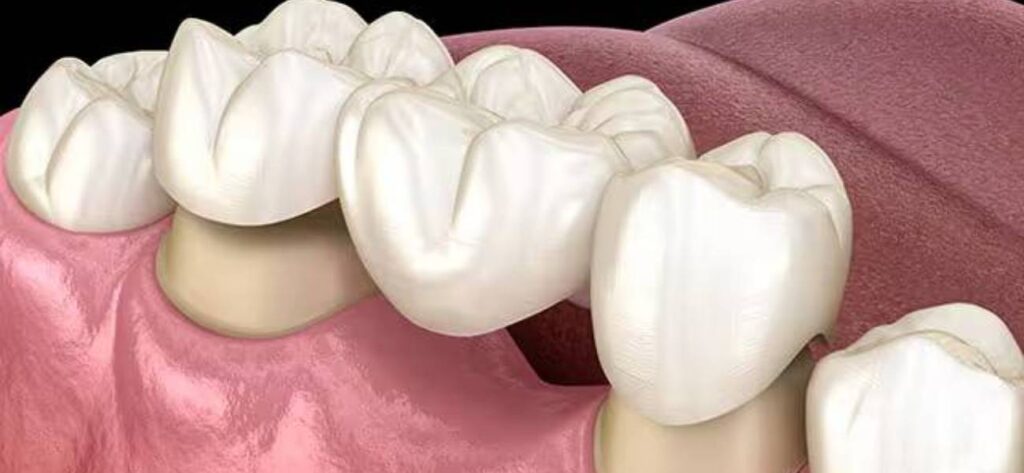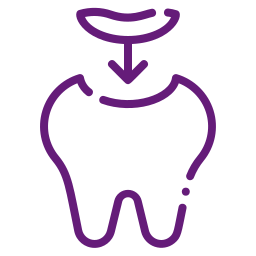Dental Bridges
Introduction to Dental Bridges
Dental bridges are a popular restorative dental solution used to replace missing teeth. When a tooth is lost due to decay, injury, or gum disease, it can create gaps that affect chewing, speech, and aesthetics. Dental bridges help fill these spaces by anchoring an artificial tooth to adjacent healthy teeth. They restore functionality, improve smile appearance, and prevent complications caused by missing teeth.
What Are Dental Bridges?
A dental bridge is a fixed prosthetic device used to replace one or more missing teeth. It consists of an artificial tooth (pontic) held in place by dental crowns attached to adjacent natural teeth or implants. Unlike dentures, bridges are non-removable and provide a long-lasting solution for missing teeth.

Talk to our Specialist
Types of Dental Bridges
There are several types of dentures, each serving different needs:
- Complete Dentures: Used when all teeth are missing in either the upper or lower jaw. They rest directly on the gums.
- Partial Dentures: Designed for patients with some remaining natural teeth, these dentures fill in the gaps and prevent teeth from shifting.
- Immediate Dentures: Placed immediately after tooth extraction, allowing patients to have teeth during the healing period.
- Implant-Supported Dentures: These are anchored to dental implants, providing more stability and preventing slipping.
- Overdentures: Fitted over remaining natural teeth or implants, improving retention and stability.
Need for Dental Bridges
Dental bridges are necessary when:
– One or more teeth are missing, creating gaps in the smile.
– Adjacent teeth are shifting due to the missing tooth.
– Difficulty in chewing or speaking arises due to tooth loss.
– Aesthetic concerns require filling the gap for a confident smile.
– Jawbone deterioration needs to be minimized by maintaining the structure.
– Adjacent teeth are shifting due to the missing tooth.
– Difficulty in chewing or speaking arises due to tooth loss.
– Aesthetic concerns require filling the gap for a confident smile.
– Jawbone deterioration needs to be minimized by maintaining the structure.
Symptoms Indicating the Need for Dental Bridges
You may need a dental bridge if you experience:
– Difficulty chewing food properly.
– Shifting or misalignment of adjacent teeth.
– Speech difficulties caused by missing teeth.
– An unbalanced bite leading to jaw pain.
– Aesthetic concerns due to a visible tooth gap.
– Shifting or misalignment of adjacent teeth.
– Speech difficulties caused by missing teeth.
– An unbalanced bite leading to jaw pain.
– Aesthetic concerns due to a visible tooth gap.
Risks of Dental Bridges
– Requires alteration of adjacent healthy teeth.
– Bridges may become loose or need replacement over time.
– Poor oral hygiene can lead to decay under the crowns.
– Potential for gum irritation or infection.
– Bridges may become loose or need replacement over time.
– Poor oral hygiene can lead to decay under the crowns.
– Potential for gum irritation or infection.
Procedure for Dental Bridges
- Consultation & Examination: The dentist evaluates the missing tooth and surrounding teeth.
- Tooth Preparation: Adjacent teeth are reshaped to accommodate crowns.
- Impression Taking: A mold is created for a custom-fit bridge.
- Temporary Bridge Placement: A temporary bridge protects the area while the permanent one is fabricated.
- Final Bridge Placement: The custom bridge is adjusted and cemented permanently.
Frequently Asked Questions
With proper care, dental bridges can last between 10 to 15 years. Good oral hygiene and regular check-ups can extend their lifespan.
The procedure is performed under local anesthesia, so it is generally painless. Mild sensitivity may be experienced after the treatment.
Yes, once the bridge is secured, you can eat normally. However, avoiding sticky and hard foods is recommended.
Maintain good oral hygiene by brushing twice daily, flossing under the bridge, and scheduling regular dental check-ups.
Dental bridges are an excellent solution for replacing missing teeth, restoring functionality, and improving aesthetics. Whether you choose a traditional, cantilever, Maryland, or implant-supported bridge, consulting a dentist can help determine the best option for your needs. Proper care and maintenance will ensure your dental bridge remains durable and effective for years to come.









